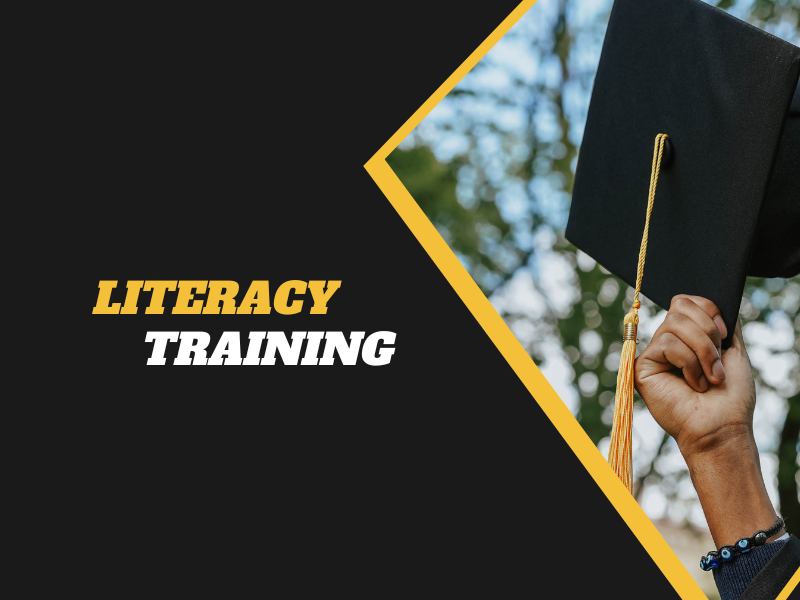Literacy is a fundamental skill that opens doors to knowledge, opportunity, and empowerment. However, access to quality literacy training has not been equitable for all communities, particularly minority and ethnic groups. Recognizing this disparity, various organizations have stepped forward to create culturally tailored literacy programs that cater to the unique needs of these communities. In this article, we will delve into the significance of literacy training among minority and ethnic groups, explore the impact of culturally tailored curricula, and highlight the value of research-backed approaches in ensuring the effectiveness of such initiatives.
The Importance of Literacy Training
Literacy and Quality of Life
Literacy is indeed a fundamental pillar of an improved quality of life. Beyond its capacity to unlock the doors to knowledge, literacy equips individuals with the skills and confidence necessary for personal and societal growth. With the ability to read, write, and comprehend, people can access a wealth of information, from healthcare resources to employment opportunities, enhancing their overall well-being. Moreover, literacy fosters active community participation, allowing individuals to engage meaningfully in civic activities, express their ideas, and contribute to social progress. In essence, literacy is not just about words on a page; it’s about empowering individuals to lead fuller, more enriched lives, and it is particularly vital for minority and ethnic communities where tailored literacy training can be a transformative force.
Empowering Communities
Literacy training serves as a catalyst for community empowerment, transcending individual boundaries to create a collective force for positive change. When communities embrace a culture of lifelong learning and knowledge sharing, a ripple effect occurs. Members become not only consumers of information but also contributors, offering their unique perspectives and insights. This dynamic exchange of ideas nurtures community cohesion and resilience. Moreover, as individuals within a community improve their literacy skills, they become better-equipped advocates for collective needs, such as improved education and healthcare services. In essence, literacy training is a vehicle for communities to not only adapt to the challenges of the modern world but also to actively shape their own destinies, making it a potent tool for enhancing the quality of life among minority and ethnic populations.
Challenges Faced by Minority and Ethnic Communities
Barriers to Literacy
Barriers to literacy within minority and ethnic communities are multifaceted and often deeply intertwined with social and cultural factors. Language barriers, for instance, can be a significant obstacle, especially when individuals are not proficient in the dominant language of the region. Limited access to educational resources, both in terms of physical infrastructure and culturally tailored materials, further compounds the issue. Additionally, cultural differences can influence attitudes toward education, with some communities valuing formal learning differently. These barriers collectively create a complex landscape that demands a culturally sensitive and research-backed approach to literacy training. By recognizing and addressing these unique challenges, literacy programs can become more effective tools for enhancing the quality of life within minority and ethnic communities, breaking down barriers that limit access to information, economic opportunities, and social participation.
Impact of Low Literacy
Low literacy rates, particularly within minority and ethnic communities, have far-reaching and detrimental effects. They often perpetuate cycles of poverty by limiting access to well-paying jobs and career advancement opportunities. Individuals with low literacy may struggle to fill out job applications, read work-related documents, or engage in further education and training. This not only impacts their personal economic well-being but also strains community resources. Furthermore, limited literacy hinders active participation in civic life, including the ability to understand and engage with government policies, participate in community activities, and exercise informed voting rights. To address these challenges and break the cycle of low literacy, culturally tailored and research-backed literacy training programs are crucial. Such programs empower individuals and communities by equipping them with the essential skills needed for personal growth, economic stability, and active civic engagement.
Culturally Tailored Literacy Training
Understanding Cultural Sensitivity
Cultural sensitivity is a fundamental aspect of designing effective literacy programs, especially when targeting minority and ethnic communities. These programs recognize and respect the unique cultural norms, values, and traditions of the communities they serve. By doing so, they create a more inclusive and welcoming learning environment, where participants feel their identity and heritage are honoured. Cultural sensitivity also acknowledges that language and communication styles may vary among different communities, and it adapts teaching methods accordingly. This approach not only makes the learning experience more relatable and meaningful for participants but also increases their engagement and motivation to acquire literacy skills. Ultimately, culturally tailored literacy programs embrace diversity as a strength, understanding that when individuals are empowered within the context of their own culture, the benefits of literacy extend more profoundly to the community as a whole.
Customized Curriculum
Customized curriculum lies at the heart of effective literacy training for minority and ethnic communities. These programs understand that one-size-fits-all approaches often fall short, as they may not address the unique needs and backgrounds of diverse learners. Customized curricula are thoughtfully designed to align with the cultural contexts, languages, and experiences of the participants. This tailored approach makes the learning process not only more engaging but also more relevant and relatable. It ensures that learners can connect with the content on a personal level, which fosters a deeper understanding and retention of literacy skills. Additionally, a customized curriculum acknowledges the varying literacy levels within a group and can be adjusted to accommodate different learning paces and styles. Ultimately, this approach empowers individuals in minority and ethnic communities to build essential literacy skills in a way that respects their cultural identity and heritage, enhancing the overall effectiveness and impact of the training.
The Role of Research
Effective Teaching Methods
Effective teaching methods are at the core of successful literacy training programs tailored for minority and ethnic communities. Research-backed approaches play a crucial role in identifying the most efficient teaching methods and appropriate materials for specific learner groups. These methods take into account the diverse cultural and linguistic backgrounds of participants, ensuring that the instruction is culturally sensitive and relevant. Research helps educators understand the unique challenges learners may face, whether it’s related to language barriers, different alphabets, or varying levels of prior education. By utilizing evidence-based strategies, educators can fine-tune their teaching to meet the specific needs of these communities, ultimately increasing the effectiveness of literacy training. This approach not only improves participants’ reading and writing skills but also enhances their overall learning experience, making it more engaging and meaningful. As a result, individuals from minority and ethnic communities can gain essential literacy skills with confidence, empowering them to navigate life’s challenges more effectively.
Continuous Improvement
Continuous improvement is a vital aspect of literacy programs tailored for minority and ethnic communities. Ongoing research plays a pivotal role in keeping these programs up-to-date, relevant, and responsive to the ever-evolving needs of diverse communities. It allows program coordinators and educators to stay informed about the latest developments in pedagogy, technology, and cultural sensitivity. Research also helps identify emerging challenges and opportunities, enabling program adjustments to better address the specific barriers learners may face. By remaining adaptable and incorporating the latest findings into their curricula and teaching methods, these programs can ensure that participants receive the most effective and culturally relevant literacy training possible. This commitment to continuous improvement not only enhances the quality of education but also strengthens the program’s impact, empowering minority and ethnic communities to overcome literacy barriers and pursue better opportunities for themselves and their families.
The Impact of Culturally Tailored Literacy Programs
Increased Participation
Culturally tailored literacy programs, with their customized curricula and culturally sensitive teaching methods, frequently lead to increased participation rates among minority and ethnic communities. When learners find that the educational materials, methods, and content resonate with their cultural backgrounds, they are more likely to feel comfortable and motivated to engage in the learning process. This increased participation not only enhances their literacy skills but also fosters a sense of ownership over their education. It encourages learners to become active participants in their communities, leveraging their newfound knowledge to access information, secure employment, and contribute positively to society. By removing cultural barriers to learning and tailoring education to the unique needs and experiences of these communities, these programs create a more inclusive and participatory educational environment, resulting in improved literacy rates and a brighter future for all involved.
Building Cultural Bridges
Culturally tailored literacy programs serve as powerful tools for building cultural bridges within communities. Beyond their primary goal of enhancing literacy skills, these programs promote deeper cultural understanding, tolerance, and a profound sense of belonging. By acknowledging and respecting the unique cultural norms, values, and traditions of specific minority and ethnic groups, these programs foster an environment where individuals from diverse backgrounds feel valued and accepted. As learners engage with curricula that resonate with their cultural identities, they not only develop vital literacy skills but also gain a greater appreciation for their own heritage and that of others. This cultural exchange enhances community cohesion, reduces stereotypes, and encourages open dialogue among community members. Ultimately, these programs play a pivotal role in breaking down cultural barriers, promoting unity, and creating a more inclusive and harmonious society where individuals from all backgrounds can thrive.
Conclusion
In conclusion, culturally tailored literacy training represents more than just an educational initiative; it’s a beacon of hope and empowerment for minority and ethnic communities. These programs recognize the unique challenges and opportunities these communities face, and through research-backed approaches, they provide the tools and resources needed for individuals to unlock their full potential. As barriers to literacy are dismantled, these communities experience a transformative shift, not only in individual lives but also in the collective strength and resilience of their communities. By embracing cultural sensitivity and customizing curricula, organizations are not just fostering literacy; they’re nurturing cultural understanding, tolerance, and a deep sense of belonging. This, in turn, paves the way for more inclusive societies where diversity is celebrated, stereotypes are shattered, and bridges of understanding are constructed. It’s a journey towards a brighter, more equitable future, where every individual, regardless of their background, has the opportunity to thrive and contribute to the richness of our global tapestry.

